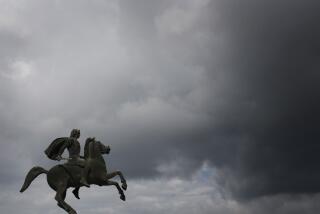End of Empire <i> by Brian Lapping (St. Martin’s: $24.95; 550 pp., illustrated) </i>
The owl of Minerva, Hegel tells us, flies only at dusk. Not the most easily understood of generalizations, it has usually been taken to mean this: that events, or movements, or institutions, are more easily perceived in their quiddity when they are over, or almost over, than when their phenomena are all about us. That which currently is, is always imbued with a false air of the normal and the inevitable.
How abundantly this is true of the phenomenon of imperialism, and particularly of the most striking variety of it, the British: (The title of this book is general, but the subject is specifically the British, as the archetypal, Empire.) Now that the pageant is over, far more books have been published in the last 20 or 25 years on the British Empire than ever were published in any similar period in its heyday. Let me say right away that, for the purposes of the general intelligent reader, this is one of the best. If you want three volumes, more anecdotes and more idiosyncrasy, go to Jan/James Morris’ imperial trilogy, otherwise, this is your best bet.
One of the most amazing things about the disappearance of the British Empire is the recency and speed of the collapse. As Brian Lapping says, “Relative to its size, no great ship ever sank so quickly.” At the end of the Second World War, the process had not even begun. It is only 40 years since, at Yalta, Franklin D. Roosevelt was displaying his usual chronic suspicions of British imperialism, and no awareness at all of Russian imperialism, a lack of perceptiveness--on both issues--that still astounds.
“Until 1947--within the lifetime of half the world’s population--the government in London ruled more land and people than any other government in history.” And to many who remember the world as it was, surely the ending of Britain’s world empire and Great-Power role is the greatest global change of the past generation--a series of events titanic in scale and titanic in evil consequence.
What has happened since 1947 is the subject of Lapping’s book, as it was of the TV series on which it is based and of which he was the producer. The TV series was made for and shown on Granada Television, one of the British commercial networks, and has not yet as far as I know surfaced on Channel 28. (We may hope that it will.) I supposed that in some circles is a kind of kiss of death to say that a work is “the book of the TV series,” but I would like to avert that reaction if possible. Lapping read history at Cambridge and was an experienced journalist, working for years for prestigious papers (the Guardian and the Financial Times) before he took to working for Granada. In his journalistic years he specialized in British Commonwealth affairs, covering the achievement of independence in many British territories and interviewing great numbers of those involved, British and other. This is the solid foundation on which his book is built. He demonstrates, indeed, a remarkable range of detailed knowledge.
He also shows, in his preface, the good sense to know that a book is not a TV program: “The best way to tell a story for television is usually not best for a book. The programmes needed anecdotes and lively talkers . . . the book . . . an ordered presentation of the main facts.” (But the book has its good anecdotes, too.)
Lapping opens with a mildly satirical description of the ceremonials typically accompanying the Transfer of Power on the independence-day of a British colony: the lowering of the flag at Government House in the afternoon for the last time, the garden-party; the great ceremony late at night in the largest local stadium before an immense crowd, the flag ceremony at exactly midnight, the speeches by the Royal representative, Prince Charles or somebody else . . . The British are good at ritual, and they became particularly good at this one. Forty-nine territories became independent from Britain in the period 1947-1980, and although there were some undignified scuttles (Palestine and Aden), in nearly all of them this wry, sad ritual was performed with punctilio.
The 500-odd pages of Lapping’s handsome, substantial book are (mercifully) not comprehensive; we don’t get all 49. Instead, in 10 chapters he deals with 10 particular cases that he regards as representative or particularly interesting. These are: India (appropriately the first and by far the longest chapter); Palestine; Malaya; Iran; Egypt; Aden; Cyprus; Gold Coast; Kenya; Rhodesia. All are tropical or subtropical areas.
Notice that the great Dominions, areas of white settlement (Canada, Australia, New Zealand, South Africa) are not dealt with, for the sensible reason that they had become substantially if not formally responsible for their own self-government long before the period dealt with; in the case of Canada, a century before. On the other hand, he includes Iran, never at any time Britain’s (or anybody else’s) colony, on the ground that the great role played by the Anglo-Iranian Oil Co. in its economy gave Britain real suzerainty there from early in this century till the 1950s. The pattern of each chapter is the same: a brief section of historical background; a main section on the “End of Empire” period, full of vivid personal observation; a summary of major events since independence.
The book is essentially a narrative (there are no footnotes, but there is a very good annotated bibliography), and Lapping tells his story with skill, verve and readability. Also with gratifying accuracy: I have not found a single error, not even a typographical one--how rare that is in these days! The illustrations and the endpaper maps are excellent. And the moral of it all? That is not so clear, but perhaps it emerges in a throwaway remark in the chapter on Palestine: “A moment comes when the wisest policy is to go quietly.” Theory--most readers will be happy to hear--is not Lapping’s forte. The only attempt I can find here at a general explanation for the rapid disintegration of that great empire which painted red the maps on the walls of my schoolrooms is to be found in the 13 lines that constitute the very last paragraph of the book. But then, come to think of it, Gibbon didn’t do much of a job, either, on analyzing the causes of that other decline and fall.
More to Read
Sign up for our Book Club newsletter
Get the latest news, events and more from the Los Angeles Times Book Club, and help us get L.A. reading and talking.
You may occasionally receive promotional content from the Los Angeles Times.







